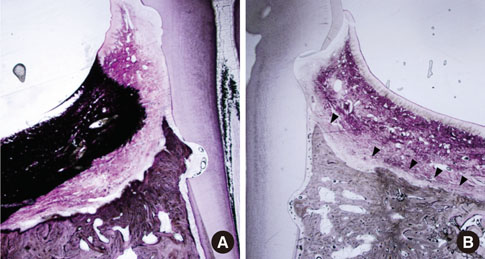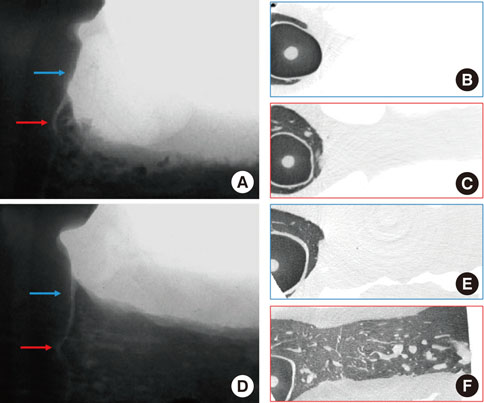J Periodontal Implant Sci.
2010 Oct;40(5):232-238. 10.5051/jpis.2010.40.5.232.
Biological effects of a porcine-derived collagen membrane on intrabony defects
- Affiliations
-
- 1Department of Periodontology and Dental Research Institute, Seoul National University School of Dentistry, Seoul, Korea. ccpperio@snu.ac.kr
- 2Department of Craniomaxillofacial Reconstructive Sciences, Seoul National University School of Dentistry, Seoul, Korea.
- 3Research Center, Nano Intelligent Biomedical Engineering Corporation, Seoul, Korea.
- KMID: 1783564
- DOI: http://doi.org/10.5051/jpis.2010.40.5.232
Abstract
- PURPOSE
To prolong the degradation time of collagen membranes, various cross-linking techniques have been developed. For cross-linking, chemicals such as formaldehyde and glutaraldehyde are added to collagen membranes, but these chemicals could adversely affect surrounding tissues. The aim of this study is to evaluate the ability of porous non-chemical cross-linking porcine-derived collagen nanofibrous membrane to enhance bone and associated tissue regeneration in one-wall intrabony defects in beagle dogs.
METHODS
The second and third mandibular premolars and the first molars of 2 adult beagles were extracted bilaterally and the extraction sites were allowed to heal for 10 weeks. One-wall intrabony defects were prepared bilaterally on the mesial and distal side of the fourth mandibular premolars. Among eight defects, four defects were not covered with membrane as controls and the other four defects were covered with membrane as the experimental group. The animals were sacrificed 10 weeks after surgery.
RESULTS
Wound healing was generally uneventful. For all parameters evaluating bone regeneration, the experimental group showed significantly superior results compared to the control. In new bone height (NBh), the experimental group exhibited a greater mean value than the control (3.04 +/- 0.23 mm/1.57 +/- 0.59, P = 0.003). Also, in new bone area (NBa) and new bone volume (NBv), the experimental group showed superior results compared to the control (NBa, 34.48 +/- 10.21% vs. 5.09 +/- 5.76%, P = 0.014; and NBv, 28.04 +/- 12.96 vs. 1.55 +/- 0.57, P = 0.041). On the other hand, for parameters evaluating periodontal tissue regeneration, including junctional epithelium migration and new cementum height, there were no statistically significant differences between two groups.
CONCLUSIONS
Within the limitations of this study, this collagen membrane enhanced bone regeneration at one-wall intrabony defects. On the other hand, no influence of this membrane on periodontal tissue regeneration could be ascertained in this study.
MeSH Terms
Figure
Cited by 1 articles
-
Comparative study of two collagen membranes for guided tissue regeneration therapy in periodontal intrabony defects: a randomized clinical trial
Young-Mi Chung, Jue-Yeon Lee, Seong-Nyum Jeong
J Periodontal Implant Sci. 2014;44(4):194-200. doi: 10.5051/jpis.2014.44.4.194.
Reference
-
1. Ramfjord SP, Knowles JW, Nissle RR, Burgett FG, Shick RA. Results following three modalities of periodontal therapy. J Periodontol. 1975; 46:522–526.
Article2. Kaldahl WB, Kalkwarf KL, Patil KD, Molvar MP, Dyer JK. Long-term evaluation of periodontal therapy: I. Response to 4 therapeutic modalities. J Periodontol. 1996; 67:93–102.
Article3. Becker W, Becker BE, Caffesse R, Kerry G, Ochsenbein C, Morrison E, et al. A longitudinal study comparing scaling, osseous surgery, and modified Widman procedures: results after 5 years. J Periodontol. 2001; 72:1675–1684.
Article4. Caton J, Nyman S. Histometric evaluation of periodontal surgery. I. The modified Widman flap procedure. J Clin Periodontol. 1980; 7:212–223.
Article5. Caton J, Nyman S, Zander H. Histometric evaluation of periodontal surgery. II. Connective tissue attachment levels after four regenerative procedures. J Clin Periodontol. 1980; 7:224–231.
Article6. Bowers GM, Chadroff B, Carnevale R, Mellonig J, Corio R, Emerson J, et al. Histologic evaluation of new attachment apparatus formation in humans. Part I. J Periodontol. 1989; 60:664–674.7. Gottlow J, Nyman S, Karring T, Lindhe J. New attachment formation as the result of controlled tissue regeneration. J Clin Periodontol. 1984; 11:494–503.
Article8. Garrett S. Periodontal regeneration around natural teeth. Ann Periodontol. 1996; 1:621–666.
Article9. Buser D, Dula K, Belser U, Hirt HP, Berthold H. Localized ridge augmentation using guided bone regeneration. 1. Surgical procedure in the maxilla. Int J Periodontics Restorative Dent. 1993; 13:29–45.10. Dahlin C, Sennerby L, Lekholm U, Linde A, Nyman S. Generation of new bone around titanium implants using a membrane technique: an experimental study in rabbits. Int J Oral Maxillofac Implants. 1989; 4:19–25.11. Simion M, Scarano A, Gionso L, Piattelli A. Guided bone regeneration using resorbable and nonresorbable membranes: a comparative histologic study in humans. Int J Oral Maxillofac Implants. 1996; 11:735–742.12. Schliephake H, Dard M, Planck H, Hierlemann H, Jakob A. Guided bone regeneration around endosseous implants using a resorbable membrane vs a PTFE membrane. Clin Oral Implants Res. 2000; 11:230–241.
Article13. Polimeni G, Koo KT, Qahash M, Xiropaidis AV, Albandar JM, Wikesjo UM. Prognostic factors for alveolar regeneration: effect of a space-providing biomaterial on guided tissue regeneration. J Clin Periodontol. 2004; 31:725–729.
Article14. Ling LJ, Hung SL, Lee CF, Chen YT, Wu KM. The influence of membrane exposure on the outcomes of guided tissue regeneration: clinical and microbiological aspects. J Periodontal Res. 2003; 38:57–63.
Article15. Parrish LC, Miyamoto T, Fong N, Mattson JS, Cerutis DR. Non-bioabsorbable vs. bioabsorbable membrane: assessment of their clinical efficacy in guided tissue regeneration technique. A systematic review. J Oral Sci. 2009; 51:383–400.
Article16. Locci P, Calvitti M, Belcastro S, Pugliese M, Guerra M, Marinucci L, et al. Phenotype expression of gingival fibroblasts cultured on membranes used in guided tissue regeneration. J Periodontol. 1997; 68:857–863.
Article17. Quteish D, Singrao S, Dolby AE. Light and electron microscopic evaluation of biocompatibility, resorption and penetration characteristics of human collagen graft material. J Clin Periodontol. 1991; 18:305–311.
Article18. Polimeni G, Koo KT, Pringle GA, Agelan A, Safadi FF, Wikesjo UM. Histopathological observations of a polylactic acid-based device intended for guided bone/tissue regeneration. Clin Implant Dent Relat Res. 2008; 10:99–105.
Article19. Minabe M, Kodama T, Kogou T, Tamura T, Hori T, Watanabe Y, et al. Different cross-linked types of collagen implanted in rat palatal gingiva. J Periodontol. 1989; 60:35–43.
Article20. Speer DP, Chvapil M, Eskelson CD, Ulreich J. Biological effects of residual glutaraldehyde in glutaraldehyde-tanned collagen biomaterials. J Biomed Mater Res. 1980; 14:753–764.
Article21. Kim CS, Choi SH, Chai JK, Cho KS, Moon IS, Wikesjo UM, et al. Periodontal repair in surgically created intrabony defects in dogs: influence of the number of bone walls on healing response. J Periodontol. 2004; 75:229–235.
Article22. Wikesjo UM, Lim WH, Razi SS, Sigurdsson TJ, Lee MB, Tatakis DN, et al. Periodontal repair in dogs: a bioabsorbable calcium carbonate coral implant enhances space provision for alveolar bone regeneration in conjunction with guided tissue regeneration. J Periodontol. 2003; 74:957–964.
Article23. Blumenthal NM, Alves ME, Al-Huwais S, Hofbauer AM, Koperski RD. Defect-determined regenerative options for treating periodontal intrabony defects in baboons. J Periodontol. 2003; 74:10–24.
Article24. Sculean A, Nikolidakis D, Schwarz F. Regeneration of periodontal tissues: combinations of barrier membranes and grafting materials - biological foundation and preclinical evidence: a systematic review. J Clin Periodontol. 2008; 35:106–116.
Article25. Muller R, Hahn M, Vogel M, Delling G, Ruegsegger P. Morphometric analysis of noninvasively assessed bone biopsies: comparison of high-resolution computed tomography and histologic sections. Bone. 1996; 18:215–220.
Article26. Butz F, Ogawa T, Chang TL, Nishimura I. Three-dimensional bone-implant integration profiling using micro-computed tomography. Int J Oral Maxillofac Implants. 2006; 21:687–695.27. Cowan CM, Aghaloo T, Chou YF, Walder B, Zhang X, Soo C, et al. MicroCT evaluation of three-dimensional mineralization in response to BMP-2 doses in vitro and in critical sized rat calvarial defects. Tissue Eng. 2007; 13:501–512.
Article28. Marechal M, Luyten F, Nijs J, Postnov A, Schepers E, van Steenberghe D. Histomorphometry and micro-computed tomography of bone augmentation under a titanium membrane. Clin Oral Implants Res. 2005; 16:708–714.
Article29. Kochi G, Sato S, Ebihara H, Hirano J, Arai Y, Ito K. A comparative study of microfocus CT and histomorphometry in the evaluation of bone augmentation in rat calvarium. J Oral Sci. 2010; 52:203–211.
Article30. Song WS, Kim CS, Choi SH, Jhon GJ, Kim HY, Cho KS, et al. The effects of a bioabsorbable barrier membrane containing safflower seed extracts on periodontal healing of 1-wall intrabony defects in beagle dogs. J Periodontol. 2005; 76:22–33.
Article31. Yeo YJ, Jeon DW, Kim CS, Choi SH, Cho KS, Lee YK, et al. Effects of chitosan nonwoven membrane on periodontal healing of surgically created one-wall intrabony defects in beagle dogs. J Biomed Mater Res B Appl Biomater. 2005; 72:86–93.
Article32. Stoller NH, Johnson LR, Garrett S. Periodontal regeneration of a class II furcation defect utilizing a bioabsorbable barrier in a human. A case study with histology. J Periodontol. 2001; 72:238–242.
Article33. Sculean A, Donos N, Chiantella GC, Windisch P, Reich E, Brecx M. GTR with bioresorbable membranes in the treatment of intrabony defects: a clinical and histologic study. Int J Periodontics Restorative Dent. 1999; 19:501–509.34. Sculean A, Donos N, Windisch P, Brecx M, Gera I, Reich E, et al. Healing of human intrabony defects following treatment with enamel matrix proteins or guided tissue regeneration. J Periodontal Res. 1999; 34:310–322.
Article
- Full Text Links
- Actions
-
Cited
- CITED
-
- Close
- Share
- Similar articles
-
- Effectiveness of porcine-derived xenograft with enamel matrix derivative for periodontal regenerative treatment of intrabony defects associated with a fixed dental prosthesis: a 2-year follow-up retrospective study
- Evaluation of calcium sulphate barrier to collagen membrane in intrabony defects
- Periodontal regenerative effect of a bovine hydroxyapatite/collagen block in one-wall intrabony defects in dogs: a histometric analysis
- Comparative study of two collagen membranes for guided tissue regeneration therapy in periodontal intrabony defects: a randomized clinical trial
- Additional use of autogenous periosteal barrier membrane combined with regenerative therapy in the interproximal intrabony defects: case series





